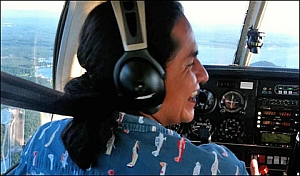A grant from the U.S. Air Force to Rensselaer Polytechnic Institute in Troy, New York will fund development of computer logic to help create safer and more efficient flight technology. The $100,00 grant was awarded to computer scientist Carlos Varela of Rensselaer’s Data Science Research Center, who is also a licensed pilot (pictured right).
Varela’s project will devise programming logic to help pilots process the constant stream of data from air traffic controllers, weather reports, and the multiple sensors throughout the aircraft. Problems can occur, however, when the dynamic decision-making needs of the pilot rely on static data sources, such as weather forecasts, that may be out of date or even incorrect. “Data should drive the flight systems in an aircraft to create active and constantly updated flight data for the pilot,” says Varela.
According to Varela, data must understand the connections with other data. A pilot or autopilot system cannot take the right action when the data they are receiving are out of date or wrong. This may have been the problem with the crash of Air France flight 447, says Varela, which crashed into the Atlantic in June 2009 killing, all on board.
Evidence from the crash suggests that the pilots on board raised the nose of the plane when it shouldn’t have been brought up, based on erroneous readings from the autopilot caused by equipment failure. Varela himself experienced a somewhat similar problem, when ice on an air speed sensor caused it to fail. Fortunately, says Varela, he had GPS readings that gave him an estimate of ground speed — providing a rough indicator of air speed — until he could deice the sensor and resume accurate air speed readings, which enabled him to safely finish the flight.
These experiences led Varela to develop new programming logic that reduces the possibility of accidents by making connections between the different data streams available to a pilot. This method creates redundancies in the data that allow the different data streams to serve as reality checks on each other. The use of ground speed to estimate air speed, as shown in Varela’s experience, is one example. Another example is flight plans based on weather and air traffic forecasts, which may be obsolete by the time of the flight.
The system Varela seeks to develop would allow for the easier and faster inclusion of new data. This kind of system would react to new data from sensors indicating changes in air pressure or temperature that would trigger dependencies with other data, such as data from the sensors that detect dangerous icing on the wings.
The new system is expected build on the current state of logic programming in computer science by extending a logic programming language to associate probabilities to other knowledge. “The programming will model the data mathematically,” says Varella, “so a pilot can tell that the data being received is wrong with some probability and have more information to make a flight decision.”
Read more: Algorithm Being Developed to Limit Small Airplane Collisions
* * *


 RSS - Posts
RSS - Posts
[…] Grant to Fund New Program Logic for Flight Data Integration […]
[…] Grant to Fund New Program Logic for Flight Data Integration […]